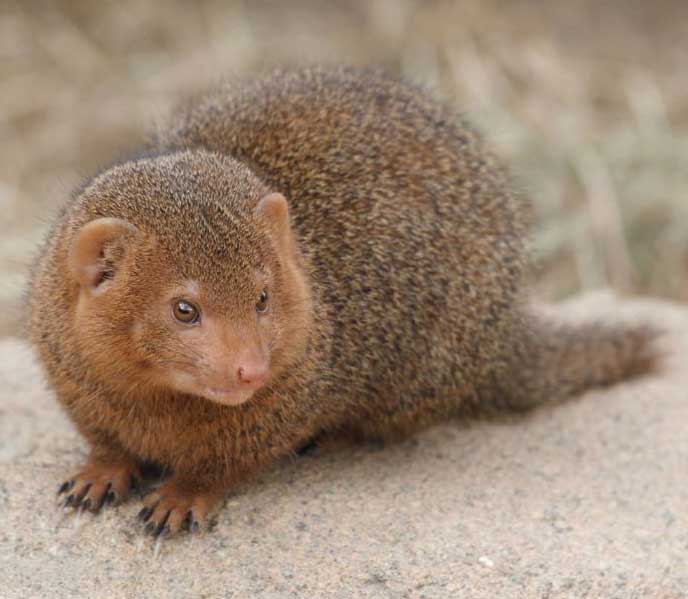Helogale parvula (*) Cladus: Eukaryota Name Helogale parvula Sundevall, 1847 Vernacular names References * Helogale parvula on Mammal Species of the World. ---------- The Common Dwarf Mongoose (Helogale parvula), sometimes just called the Dwarf Mongoose, is a small African carnivore belonging to the mongoose family (Herpestidae). The Common Dwarf Mongoose is a typical mongoose: it has a large pointed head, small ears, a long tail, short limbs, and long claws. The species can be distinguished from other mongooses by its size. It is much smaller than most other species (18 to 28 cm, 210 to 350 grams); in fact, it is Africa's smallest Carnivore. The soft fur is very variable in color, ranging from yellowish red to very dark brown. Distribution and habitat The Common Dwarf Mongoose is primarily found in dry grassland, open forests, bush land, up to 2,000 meters in altitude. It is especially common in areas with many termite mounds, their favorite sleeping place. The species avoids dense forests and deserts. The Common Dwarf Mongoose can also be found in the surroundings of settlements, and can become quite tame. Behavior The Common Dwarf Mongoose is a diurnal animal. It is a social species that lives in family groups of two to thirty animals. There is a strict hierarchy within a group, headed by a dominant pair. The dominant female is usually the leader of the group. All group members cooperate in helping to rear the pups and guarding the group from predators. Dwarf mongooses are territorial, and each group uses an area of approximately 30-60 hectares (depending on the type of habitat). They sleep at night in disused termite mounds, although they occasionally use piles of stones, hollow trees, etc. Territories often overlap slightly, which can lead to confrontations between different groups. Generally, only the group's dominant female becomes pregnant and she is responsible for 80% of the pups reared by the group. If conditions are good, subordinate females may also become pregnant but their pups rarely survive. After the gestation period of 53 days, 4-6 young mongooses are born. They remain below ground (within a termite mound) for the first 2-3 weeks. Normally one or more members of the group stay behind to babysit while the group goes foraging. At 4 weeks of age the pups begin accompanying the group. A mutualistic relationship has evolved between Dwarf Mongooses and hornbills, in which hornbills seek out mongooses in order to forage together and warn each other of nearby birds of prey and other predators.[2] Diet The diet of the Common Dwarf Mongoose consists of insects (mainly beetle larvae, termites, grasshoppers and crickets), spiders, scorpions, small lizards,snakes, small birds, and rodents, and is supplemented very occasionally with berries. References
Source: Wikispecies, Wikipedia: All text is available under the terms of the GNU Free Documentation License |
|


